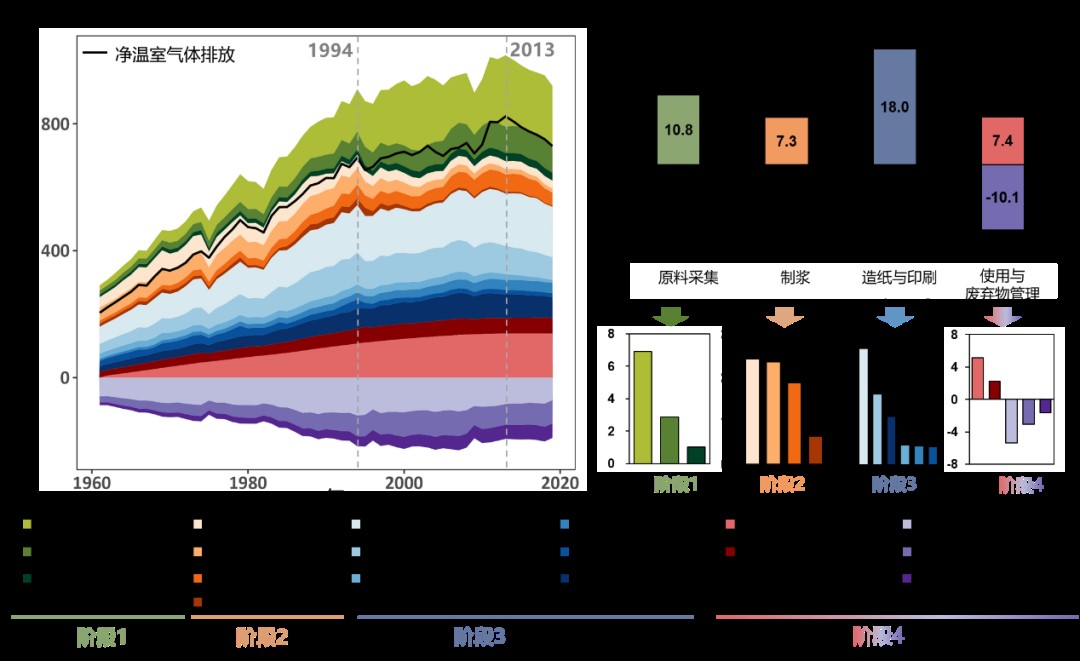

Global greenhouse gas emissions related to paper production from 1961 to 2019.
Net zero emissions, also known as carbon neutrality. Recently, the international academic journal "Nature" published online its first research article on net-zero emissions in the paper industry, saying that by 2050 , China and other countries around the world will improve energy efficiency, improve energy structure, and promote sustainable forest management. The paper industry in 30 countries is on track to achieve net-zero emissions.
This research was led by the team of Professor Wang Yutao from the Department of Environmental Science and Engineering of Fudan University and Fudan Tyndall Center, and was completed in cooperation with relevant domestic and foreign units. The title of the paper is "Country-specific net-zero strategies of the pulp and paper industry." Dr. Dai Min, the first author of the paper, told The Paper that the biggest discovery of the study is that it reveals for the first time the greenhouse gas emission characteristics of the paper industry in the world's major paper production and consumption countries from a system perspective, and proposes how different countries will achieve net net results in the industry in 2050. A differentiated strategy for zero-emission targets.
Emission of 43.5 billion tons of carbon dioxide in 59 years
The 28th Conference of the Parties (COP28) to the United Nations Framework Convention on Climate Change (UNFCCC) pointed out that the current action window to achieve the 1.5 degrees Celsius target of the Paris Agreement is rapidly narrowing, emphasizing that countries should take deep emission reduction measures as soon as possible of urgency.
The paper industry is one of the major contributors to global anthropogenic greenhouse gas emissions. According to data provided by the International Energy Agency (IEA), an intergovernmental international organization headquartered in Paris, France, the direct carbon dioxide emissions of the paper industry once ranked fourth among the global industrial sectors and currently rank fifth.
The papermaking industry has a long industrial chain, involving forestry, chemical industry, energy, recycling and other industries. These industries interact with the papermaking industry in the stages of raw material collection, product production, waste management and other stages, and jointly affect the greenhouse gas emissions of the papermaking industry.
This study established the first long-term (1961-2019), multi-stage, multi-process, high-resolution greenhouse gas emissions data set of the paper industry covering 30 major paper production and consumption countries in the world. Emission hot spots were identified from multiple dimensions.
Research results show that from 1961 to 2019, the global paper industry accumulated greenhouse gas emissions of 43.5 billion tons of carbon dioxide, of which the carbon stocks formed in the use and waste management stages offset more than 10 billion tons of carbon emissions. Greenhouse gas emissions from the raw material collection stage and the use and waste management stage account for almost half of total emissions, highlighting the importance of reducing emissions beyond the production stage. Among them, greenhouse gas emissions (forest carbon emissions) caused by deforestation and forest degradation caused by unsustainable pulpwood logging account for 64% of the total emissions from raw material collection, or 6.9 billion tons of carbon emissions.
Scenario analysis results show that improvements in energy structure and energy efficiency are the most effective emission reduction measures, able to achieve average emission reductions of 64% and 41% respectively in 30 countries. Five countries, including Indonesia, India, China, the United States and Brazil, will have a significant impact on greenhouse gas emissions in the global paper industry in 2050, reaching 51 million to 826 million tons. They may play a leading role in the decarbonization process of the global paper industry. Needs to be focused on.
The paper states that most developed countries can achieve net-zero emissions through a single measure, while the realization of net-zero emissions goals in most developing countries requires the close coordination of multiple stages of measures. In addition to measures such as energy efficiency improvements and energy transition, tropical developing countries rich in forest resources should prioritize strengthening sustainable forest management. For example, improving wood harvesting practices is more effective for these countries. Other developing countries should pay more attention to measures related to waste paper management. For countries such as Egypt, France, and New Zealand, improving the waste treatment structure and increasing the methane capture rate will have better results. In addition, the recycling rate can have different impacts on the greenhouse gas emissions of the paper industry in various countries by affecting the material flow in all aspects of the paper industry.

Saving paper and sorting waste is something everyone can do to achieve net-zero emissions.
"Tips" to decarbonize China's paper industry
This research work emphasizes the need to study the greenhouse gas emission characteristics of the paper industry from a systemic perspective, and proposes differentiated strategies for the paper industry in different countries to achieve net-zero emissions taking into account regional heterogeneity. The zero-emission target provides an important scientific reference.
How can China’s paper industry achieve net-zero emissions?
Dai Min told The Paper that first of all, it is necessary to improve the energy efficiency of the paper industry and optimize its energy structure, which is the most effective decarbonization measure for the industry. Since the implementation of energy consumption quota standards, the energy efficiency of the production lines of many leading enterprises in China has reached the international advanced level, but from a national perspective, unit energy consumption still needs to be further reduced. The energy consumption in the production process of the paper industry should reduce the use of coal power and coal, and increase the use of renewable energy such as biomass, hydropower, and wind power. In particular, making full use of by-products in the production process, such as wood scraps, black liquor, etc., to supply the energy used in pulping and papermaking processes can significantly reduce the carbon intensity of energy consumption in the production stage. Secondly, non-energy resource utilization or well-managed landfilling of some repeatedly recycled and poor-quality waste paper can offset emissions by increasing carbon stocks . Saving paper and classifying waste are efforts that everyone can make to decarbonize the paper industry.
Dai Min said that this research lasted nearly 4 years from the initial conception to the official launch of the paper. As early as more than ten years ago, Professor Wang Yutao's team had begun to pay attention to the carbon emissions issue in the paper industry. Over the years, Wang Yutao's team has been deeply involved in this field. Not only did it successfully carry out overseas clean production demonstration projects in Malaysian papermaking enterprises based on the results of this research, it also formulated carbon neutral standards related to the papermaking industry and constructed a carbon emission-related system for the papermaking industry. The database has been designed into an online platform, and the paper industry-related monograph written by the team will be published soon.
